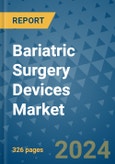The global bariatric surgery devices market is poised for significant growth during the period 2024-2031, according to a comprehensive report. The market is expected to surge from US$ 2.2 Billion in 2024 to US$ 3 Billion by 2031, driven by a range of factors and recent developments.
Furthermore, the United States has a comparatively higher acceptance rate for surgical weight-loss procedures, which is a driving factor for the bariatric surgery devices market. Increased awareness of obesity management and the presence of prominent medical device companies in the region are also contributing to market growth.
In the Asia Pacific region, growth is expected to be steady, with countries like China and Japan showing promising potential. Factors such as a growing teenage and adult population, a rising incidence of comorbidities like diabetes, an uptick in bariatric procedures, and government initiatives to combat obesity are expected to drive the expansion of the bariatric surgery devices market in this region.
This product will be delivered within 1-3 business days.
Impact of COVID-19 on the Bariatric Surgery Devices Market
The COVID-19 pandemic disrupted the bariatric surgery devices market, as elective surgeries were postponed or canceled to accommodate the urgent needs of COVID-19 patients. However, efforts to combat the virus and increasing investments in infrastructure and surgery scheduling are contributing to a resurgence in demand for bariatric surgery devices.Market Dynamics
Factors Contributing to Growth: The growing prevalence of morbid obesity worldwide, including childhood obesity, is a significant driver for bariatric surgery devices. The rise in chronic diseases associated with obesity is also fueling market growth. Furthermore, the availability of skilled bariatric surgeons is boosting the adoption of these devices.Key Challenges:
Increased product recalls and the cost of bariatric surgeries are among the primary obstacles to market growth. Post-surgical complications, such as infection and gastrointestinal issues, hinder the adoption of bariatric surgery devices.Segmentation Outlook:
The bariatric surgery devices market is segmented by type, procedure, and region. Minimally invasive surgical devices, stapling devices, energy/vessel sealing devices, suturing devices, accessories, and non-invasive surgical devices constitute the types of devices in the market. The minimally invasive surgical devices segment is expected to have a CAGR of 3.5% through 2031, driven by the rising prevalence of obesity and the demand for fewer incisions.Regional Analysis:
The regional analysis of the Bariatric Surgery Devices Market reveals significant trends and growth prospects in key regions. In North America, the market is expected to see substantial revenue growth due to the region's increasing obese population. The United States, in particular, is anticipated to experience steady growth with a notable Compound Annual Growth Rate (CAGR). The prevalence of obesity in the United States, projected to remain high, is contributing to a rise in chronic diseases among adults.Furthermore, the United States has a comparatively higher acceptance rate for surgical weight-loss procedures, which is a driving factor for the bariatric surgery devices market. Increased awareness of obesity management and the presence of prominent medical device companies in the region are also contributing to market growth.
In the Asia Pacific region, growth is expected to be steady, with countries like China and Japan showing promising potential. Factors such as a growing teenage and adult population, a rising incidence of comorbidities like diabetes, an uptick in bariatric procedures, and government initiatives to combat obesity are expected to drive the expansion of the bariatric surgery devices market in this region.
Intensifying Competition
The bariatric surgery devices market is highly competitive, with companies focusing on innovation and efficiency. Recent developments in the market include:- Standard Bariatrics, Inc.'s invention of the Titan SGS™, offering surgeons the industry's longest continuous staple cutline for sleeve gastrectomy.
- Apollo's FDA clearance for the use of polypropylene suture in OverStitch Endoscopic Suturing devices, leading to increased margins and reduced reliance on third parties.
- Intuitive Surgical's expansion of its global presence with the opening of the MEE Commercial Centre in Freiburg (Breisgau), and Medtronic's acquisition of Digital Surgery, a player in surgical artificial intelligence, data, and analytics.
Market Segmentation
By Type
- Minimally Invasive Surgical
- Stapling Devices
- Energy/Vessel Sealing Device
- Suturing Devices
- Accessories
- Non-Invasive Surgical Devices
By Procedure
- Sleeve Gastrectomy
- Gastric Bypass
- Revision Bariatric Surgery
- Non-Invasive Bariatric Surgery
- Adjustable Gastric Banding
- Mini-gastric Bypass
- Biliopancreatic Diversion with Duodenal Switch
By Region
- North America
- Latin America
- Europe
- Asia Pacific
- Middle East & Africa
This product will be delivered within 1-3 business days.
Table of Contents
1. Executive Summary
2. Market Overview
3. Global Bariatric Surgery Devices Market Outlook, 2018 - 2031
4. North America Bariatric Surgery Devices Market Outlook, 2018 - 2031
5. Europe Bariatric Surgery Devices Market Outlook, 2018 - 2031
6. Asia Pacific Bariatric Surgery Devices Market Outlook, 2018 - 2031
7. Latin America Bariatric Surgery Devices Market Outlook, 2018 - 2031
8. Middle East & Africa Bariatric Surgery Devices Market Outlook, 2018 - 2031
9. Competitive Landscape
10. Appendix
Companies Mentioned
- Ethicon
- Medtronic
- Intuitive Surgical
- Apollo Endosurgery
- ReShape Lifesciences
- Aspire Bariatrics
- Mediflex Surgical Products
- Spatz FGIA
- Cousin Biotech
Methodology

LOADING...








